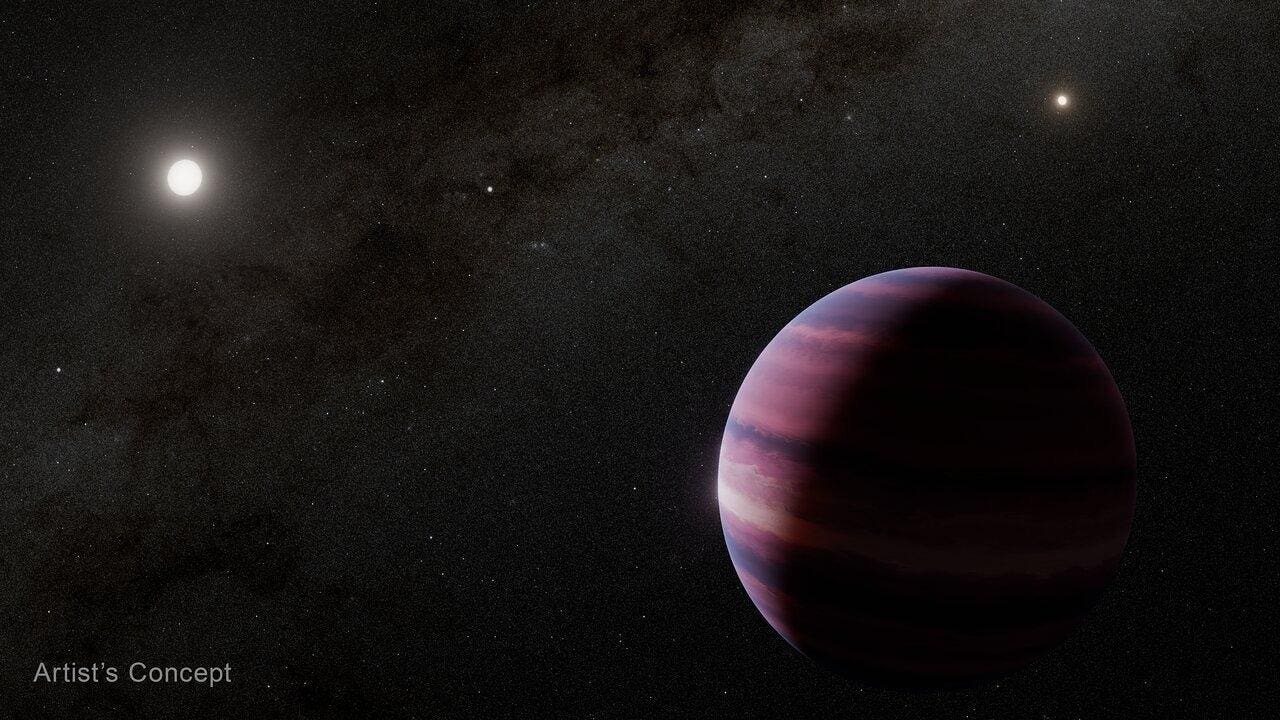This artist’s concept shows what the gas giant orbiting Alpha Centauri A could look like.
NASA, ESA, CSA, STScI, R. Hurt (
NASA has announced the probable discovery of a giant planet orbiting Alpha Centauri A, one of the closest stars to the solar system. If confirmed, it would be the nearest planet ever detected around a sun-like star. Although it’s in the habitable zone of the star, it’s a gas giant, so it would not support life as we know it.
Astronomers using the James Webb Space Telescope found a planet while observing Alpha Centauri, a system of three stars orbiting each other — binary stars Alpha Centauri A and B, along with the red dwarf star Proxima Centauri. They’re just four light-years from the solar system.
Breakthrough Discovery
It’s been known for some time that three planets are orbiting Proxima Centauri, but planets around Alpha Centauri A — a star much like the sun — have until now proved elusive.
The breakthrough came when astronomers used a coronagraph — a disk to block the bright starlight — from Alpha Centauri A, revealing a faint object around it. Around 10,000 times dimmer than the star, the planet is about twice as far from its star as Earth is from the sun. The evidence was published across two papers in The Astrophysical Journal Letters.
Possible Saturn-Mass World
Based on brightness and simulations, researchers believe the object could be a gas giant about the mass of Saturn — though additional observations will be needed to confirm the planet’s existence. The discovery at Alpha Centauri A — the third brightest star in the night sky — could be a massive breakthrough for planetary scientists wanting to learn more about exoplanets (planets orbiting stars other than the sun).
“With this system being so close to us, any exoplanets found would offer our best opportunity to collect data on planetary systems other than our own,” said Charles Beichman, NASA’s Jet Propulsion Laboratory and the NASA Exoplanet Science Institute at Caltech’s IPAC astronomy center, co-first author on the new papers. “Yet, these are incredibly challenging observations to make, even with the world’s most powerful space telescope, because these stars are so bright, close, and move across the sky quickly.”
Disappearing Planet?
However, it’s not entirely clear that this planet exists at all. First sighted in 2019 by the European Southern Observatory’s Very Large Telescope, astronomers spotted it in August 2024, using the coronagraph in Webb’s MIRI instrument. However, light from Alpha Centauri B made it a difficult observation. Attempts to confirm the planet’s existence in February 2025 and April 2025 did not succeed.
Researchers were not surprised, having modelled where the planet ought to be on its elliptical orbit. “We found that in half of the possible orbits simulated, the planet moved too close to the star and wouldn’t have been visible to Webb in both February and April 2025,” said Ph.D. student Aniket Sanghi of Caltech in Pasadena, California, the co-first author on the two papers covering the team’s research. “Its very existence in a system of two closely separated stars would challenge our understanding of how planets form, survive, and evolve in chaotic environments.”
It’s hoped that NASA’s Nancy Grace Roman Space Telescope, set to launch as soon as 2026, could complement Webb’s infrared data with visible-light observations, helping confirm the planet and figure out its size and composition. Either way, Alpha Centauri A’s gas giant will be a prime target for the next generation of astronomers and telescopes.
Wishing you clear skies and wide eyes.








